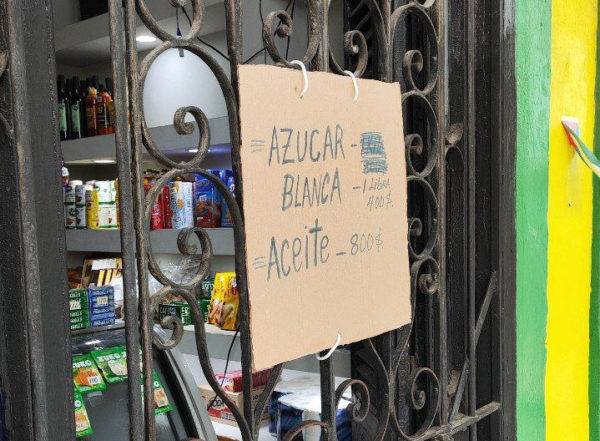The Sugar Crisis in Cuba
Hard To find, expensive and forces some private businesses to close.

A pound of sugar sells for up to 500 pesos in private stores. An average monthly salary could buy around 10 pounds.
HAVANA TIMES – Sugar is once again scarce in Cuba. Its distribution in the rationed market has delays of months and has not reached all the provinces. A small amount can be obtained in private stores for up to 500 pesos a pound.
Thus, the popular phrase that shows the traditional importance of this product for the Island – “without sugar there is no country” – sounds like a macabre joke. Roberto, a resident of Santiago de Cuba, tells 14ymedio, “Here we put sugar in everything, even if it’s not healthy. When you don’t have anything to eat, you can put it on bread or prepare a glass of sugar water.”
However, obtaining it in the current crisis is not easy. “Where I live, for example, you can’t find it. You have to look somewhere else,” he says. After making a pilgrimage through the city, Roberto found a pound of sugar at 400 pesos: “Very expensive.”
The shortage has repercussions not only for consumers, but also for small businesses.
Maribel, a resident of Nuevo Vedado, in Havana, witnessed a few weeks ago the closure of a private business in her neighborhood due to lack of sugar: “The candy store in our neighborhood has not been able to reopen because of the high price of sugar. It was a MSME [private store], but it is already in liquidation. It’s a shame, because its owner, a woman in her 50s, employed at least two young people in the area who now have no income.”
According to the habanera, “people who complained about how expensive the sweets were in that MSME now sigh when they pass by, because it was the only pastry, cake and cupcake business for several blocks around.”
On social networks, Internet users also ask desperately if someone is selling the product at affordable prices, either for the children’s snack or to make a dessert that appeases hunger. “I’ve been trying to find sugar for days, whether white or brown. In the MSMEs near home they sell a kilogram for 950 pesos,” says a user on Facebook, who nostalgically remembers “the country of sugar cane, in the times when even a milordo (sweetened water) was often breakfast, snack and dessert.”
In addition to the high prices, there are failures in distribution through the rationed market, which in recent months has not been fully stocked. In fact, some provinces received barely a part of the food that makes up the subsidized basic basket.
A kilogram of sugar is now more than two dollars on some Internet sites that sell products to emigrants for their relatives on the Island. At the informal exchange rate, the price is equivalent to 350 pesos a pound. With that, Maribel says, it was impossible for the candy store in her neighborhood to stay on its feet: “The lack of sugar buried it.”
A similar disappearance of the product was reported by 14ymedio in November last year. The emblematic Coppelia ice cream parlor, in the heart of El Vedado in Havana, closed because there was no “milk or sugar” in the factory that supplies it.
The natural medicine industry has also been a victim of the collapse of sugarcane production. Among the problems for generating these medications is not just a lack of some plants. Up to 15 imported raw materials are needed, in addition to alcohol – to extract the active metabolites of plants – and sugar, basic for the production of syrups.
Likewise, Cuban rum makers fear that this year the production of the drink will be diminished by the failure of last season’s harvest and the foreseeable fiasco of the current one. Executives of the export brands – Havana Club, Ron Santiago and Ron Vigía – point out that “the blow is felt” in the industry because of the shortage of sugar.”
Traditionally, Cuba consumed 700,000 tons of sugar and exported the rest, but with current production, the panorama has changed radically. Now Cuba has been forced to import much of the sugar it needs for its population and is unable to comply with export contracts.
Since 2020, each sugar harvest carried out on the Island is listed as the worst of the last 100 years. The amount projected for 2024-2025 is not yet known, but the authorities expect production to exceed the 350,000 tons of sugar obtained in 2023, a figure barely greater than half of what was produced in the same period (600,000 tons) by the Republic of Mauritius, an island of 2,040 square kilometers east of Africa that is 50 times smaller than Cuba.
Translated by Regina Anavy for Translating Cuba.






Any reason the yield of sugar is down? Less Acreage? I don’t see a housing boom. Trouble with refining? Labor shortage? I doubt that those are the people flying out. Empty the jails .